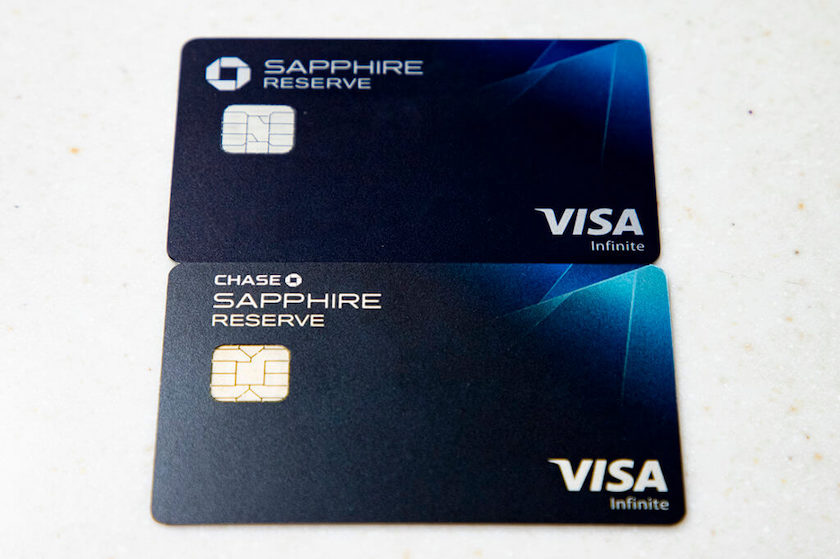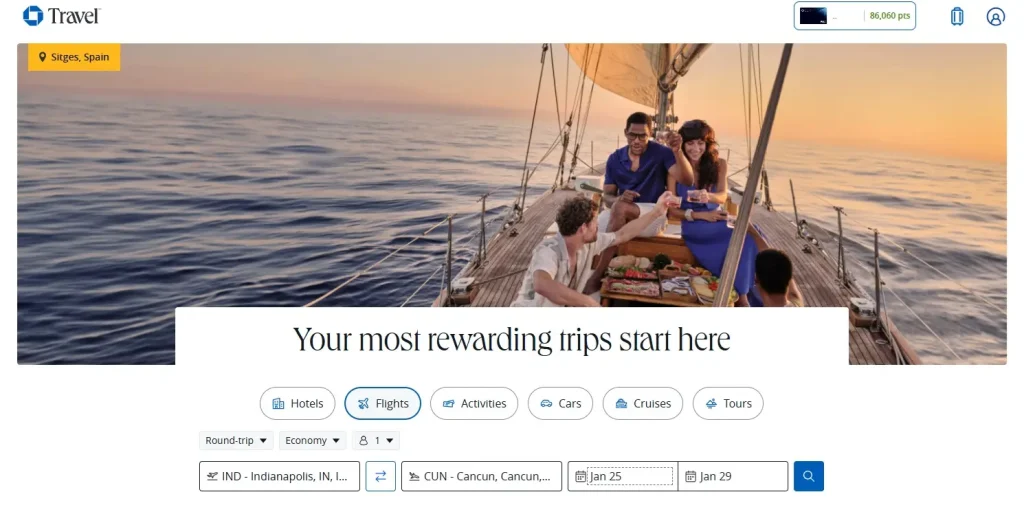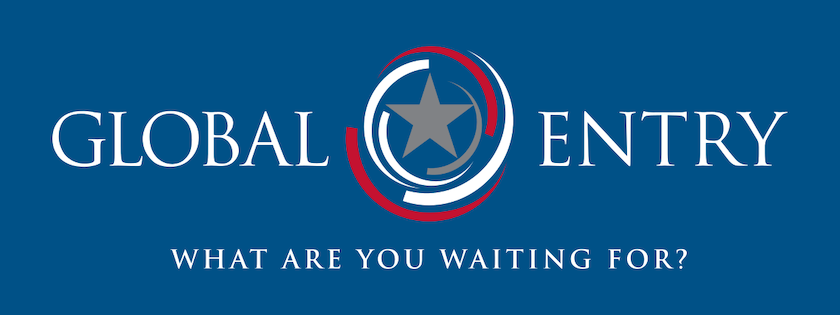The Valuable Sapphire Reserve Visa – 5 Reasons it is Our Go-To Card

Credit card points can save you a lot of money on travel, but the level of value for different cards varies widely based on your personal usage, priorities, and goals. For us, putting most of our spend on the Chase Sapphire Reserve card is the best way to maximize our points.
At this time, the annual fee for the Sapphire Reserve is a whopping $550. Just seeing that is probably enough to cause most people to move along, and look at other low-fee or no-fee cards. But it may be worthwhile to look a little deeper into the benefits before dismissing it completely.
** Please note that some links on this page are affiliate links, meaning we may earn a very small commission if you apply through them (at no extra cost to you). We only recommend cards we use ourselves, whether or not they offer affiliate links.
Table of Contents
Sapphire Reserve Benefits Overview
The Reserve card has a dizzying array of benefits, and I can’t imagine anyone finds all of them useful. So the trick is to figure out which ones you would use (even without the card) and calculate their value. These are benefits you receive even if you don’t earn a single point on the card.
Here is a list of the higher value benefits:
Annual Travel Benefit
With the Sapphire Reserve card, you will receive an automatic credit of $300 for the first $300 of travel you spend each year. The definition of travel is quite broad and includes hotels, Airbnb, VRBO, plane and train tickets, cruises, rental cars, ferries, toll roads, parking fees, cabs, and more. You don’t need to do anything to activate the credit; it just automatically appears on your account within a day or so after a travel fee is processed.
If you’re reading this blog, you almost certainly spend more than $300/year on these items. This alone brings the annual fee of the card down to $250.
Credit for Global Entry or TSA PreCheck Fee
You will receive a nearly instant credit for your Global Entry or TSA PreCheck Fee every four years. They make time in the airport much easier by providing shorter security lines and removing requirements such as taking off your shoes, belt, and jacket, removing your electronics from your luggage, and bagging your liquids separately (though you still have to comply with the 3.4 oz rule). Global Entry allows expedited clearance for pre-approved, low-risk travelers upon arrival in the United States, basically skipping the often crazy-long lines for customs.
Global Entry fee is $120 at this time and includes TSA PreCheck. So if you travel internationally, even occasionally, Global Entry is the way to go.
If you have recently applied for or renewed one of the programs, you can charge a family member or friend’s fee on your card and receive the same benefit.
Airport Lounge Access
Have you seen the signs for the lounges in airports such as the United Club, the Sky Lounge, and the Admiral’s Club in airports and wondered, wistfully, what was inside?
The Reserve card holds the key to accessing at least some of the lounges. (These lounges are generally only located in major airports.) Reserve cardholders receive access to the Chase Sapphire Lounges and Priority Pass lounges (excluding restaurants) for themselves and up to two guests. These lounges provide comfortable seating, free food and drinks, and various benefits depending on the location such as showers, complimentary spa treatments, private rooms, etc. They are a pleasant oasis before a flight or during a long layover.
DoorDash Subscription
Sapphire Reserve cardholders qualify for a free DoorDash Subscription (through at least 2027), waiving the delivery fees and reducing the service fees on restaurant deliveries over $12, and grocery deliveries over $25. It also provides a $5 per month credit on restaurant deliveries.
Edit by Chase Travel
Being a Reserve cardholder entitles you to a luxury hotel benefit. For most of us, it might not be a benefit that is used frequently, but when it is used, it provides an excellent value. Edit by Chase Travel partners with a curated list of outstanding hotels.
The hotels Chase partners with are generally available in big cities or posh resort towns (world-wide).
When you book them through the Chase Travel Portal (via cash or using points), you generally receive the market rate price, but also receive:
- Complementary full breakfast for two
- Room upgrade (when available)
- $100 property credit for the bar, dining, spa, activities, etc
- Early check-in/late check-out (when available)
- A welcome amenity
We have only used this benefit only twice, but both hotels have been amazing and welcoming, with every amenity imaginable, and we’ve received upgrades to suites both times. They have been truly memorable experiences!
Earning Points
The benefits above are given without the use of any points. But to unlock the most valuable features of the card, you must use it for as many purchases as possible. The Reserve card is most beneficial for people who charge nearly everything on their card, from a cup of coffee to groceries to utility bills (as long as the utility company doesn’t charge extra for it). It’s not that you’re actually spending more money – you would buy that coffee and those groceries anyway. Rather, you are consolidating your spending so that you pay it all off once a month, rather than incrementally. (The card is most beneficial to users who pay off the full balance each month, avoiding interest charges.)
Sign on Bonus
When you apply for and are approved for a Sapphire Reserve card, you will be offered a huge number of points to spend a certain amount of money in a certain amount of time. The spending requirement is generally in the range of $3000 – $4000 in the first 3-4 months. This sounds like a lot, but if you put everything you spend on the card, you’ll be amazed at how quickly it adds up.
The sign-in bonus fluctuates, and it is a good idea to keep an eye out for the best deal. It is generally at least 60,000 points but has risen to 75,000, 80,000, and even 100,000 on occasion. These points alone, when used most efficiently, can be worth twice the annual fee, and even more.
Everyday Spending
Each time you use the Reserve card, you receive a point for every dollar. In addition, there are bonus categories that automatically give you additional points for every dollar. Those categories are:
- Dining in any restaurant world-wide – 3 points per dollar
- Travel (hotels, plane/train fare, cabs, vacation rentals, car rentals, parking fees, etc) – 3 points per dollar
- Flights purchased through the Chase Travel Portal* – 5 points per dollar
- Hotels and car rentals purchased through the Chase Travel Portal* – 10 points per dollar
*The Chase Travel Portal is an online booking platform, easily accessed from your Chase Sapphire Reserve account. It allows you to book any type of travel at market prices, and sometimes below market prices. You can pay for the travel with cash (by putting the cost on your card) or using the points you have earned. Cash purchases earn the extra bonus points.
Spending Your Points
Spending your Chase Reserve points is where you have to put a little effort into “playing the game”. There are a variety of ways to use them, and no single way is always the answer.
Your points can always be redeemed for cash, gift cards, or statement credit at 1 cent per point. For instance, if you received a 60,000-point sign-on bonus, you could use that to get $600 in cash. However, that provides the least value per point.
The other two ways of using your points are to transfer to travel partners, or to book through the Chase Travel Portal, accessible through your online Reserve account.
Transferring to Travel Partners
This method has the potential to give the most value, by far, for your points. Your Reserve points can be transferred to your existing loyalty program accounts. For example United’s Mileage Plus or Hyatt’s World of Hyatt. It is free to join these loyalty programs.
Airline travel partners include United, Southwest, Air Canada, Air France, and Virgin Atlantic among others. Hotel partners include Hyatt, Marriott, and IHG Hotels & Resorts.
Transfers of some or all of your Chase Reserve points are easy to accomplish from your online account, and usually take place right away, but can take up to a couple of days before they show up in your account.
Airlines
Using the example of a 60,000-point sign-on bonus, you could transfer your points to achieve the following:
By transferring Reserve points to your United Mileage Plus Account, you could escape the winter cold and buy two round-trip tickets from Chicago to Orlando in February at 26K points each (totaling 52K points). Purchasing the same two tickets with cash would cost $926 (at the time of this writing). This is a value of 1.7 cents per point, 70% more than redeeming them for cash.
Similarly, by Transferring to your Air Canada Aeroplan account, you could purchase two round-trip tickets from Chicago to Vancouver, B.C. for 25K each (totaling 50K points) rather than paying the $816 cash price. The value here is 1.6 cents per point, a 60% increase over redeeming the points for cash.
Once you accumulate more points, you can unlock international premium economy and business class seats, making your journey more restful and comfortable. Premium Economy (not to be confused with economy plus) has blossomed in recent years and usually includes large, nicely reclining seats (but not lie-flat), extra legroom, amenity kits, and upgraded complimentary food and beverages. It can be far fewer points than full business class. With 150K points or more, you can often find such flights. With most airlines you can even book one direction of the trip in one class, and the return trip in a different class.
The challenge is that airline prices and point redemptions change constantly, as they have all changed, unfortunately, to dynamic pricing. So it does take a bit of time to make the most of your points in this way.
Hotels
For hotels, Hyatt is hands-down the best transfer partner. Hyatt offers excellent point redemptions compared to other large chains. For example, in New York City in May, you can stay in Hyatt’s lower-end, (but still quite nice), Hyatt Place Midtown, for $525 per night. Or you can transfer 20K Chase Reserve points per night to your World of Hyatt account. Those points have an outstanding value of 2.6 cents each.
At the upper end, you can stay at the ultra-luxurious Park Hyatt for a whopping $1669 per night or you can transfer 40K Chase Reserve points. Those points have an extraordinary value of 4.1 cents each. As an illustration, if you used your sign-on bonus of 60,000 points with that type of redemption value, it would make them worth $2460! (Enough to cover your annual fee for four years and then some.) That value is not the norm, but at the same time, it is not particularly unusual if you take the time to research.
Spending Points in the Chase Travel Portal
The other, (and, honestly, easier) way to spend your points is to book your flights, hotels, car rentals, cruises, etc. through Chase Travel. It is easy to do through your portal, but you can also call in and get excellent assistance and guidance with the booking.
Your points are worth a fixed 1.5 cents per point, which is still 50% higher than using them for cash or a statement credit.
True, it is a far cry from the 3-4 cents per point you can get in many circumstances with transfers to travel partners. But the fact is, those levels of redemptions aren’t always available when you want them, and they take a fair amount of effort. Sometimes 1.5 cents per dollar is close to the best you’re going to get under any circumstances, particularly with peak-time airline tickets.

Booking straight from the portal has a lot of advantages. First of all, it is easy. All the choices are laid out in front of you with a running tally of how many points you’ll need to book something for free. In addition, you can book packages with flights, hotels, rental cars, and even activities, such as tours.
Second, you’re not limited to the Chase transfer partners. You can book almost any airline or hotel chain through the portal.
Third, it is very flexible. You don’t have to book completely on your Reserve points; in fact, you don’t have to use any at all if you don’t want to! You can use any combination of points and cash, which is perfect for when you don’t have enough points to book a trip, but don’t want to pay for it all in cash.
Fourth, any portion you pay for in cash (by putting it on your Reserve card) gets you anywhere from 5-10 points per dollar to spend on your next trip!
And finally, the trips you book count as a paid stay at hotels and as a paid fare on airlines, so you’re earning points and status with the individual loyalty programs, while still paying nothing (or at least less) for the trip.
Conclusion
The Chase Sapphire Reserve is not for everyone. But if you travel each year and spend at least $300, fly sometimes, enjoy staying in nice hotels, and are willing to put in a little effort, it just might be the card for you.
Looking for a card with a lower fee? Understandable! Here is our article on other options: An Easy Guide to Starting Your Points Journey
Discover more from Werthwhile Wandering
Subscribe to get the latest posts sent to your email.








